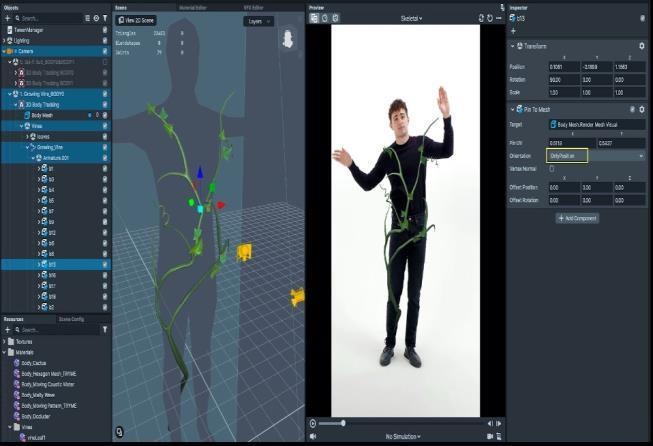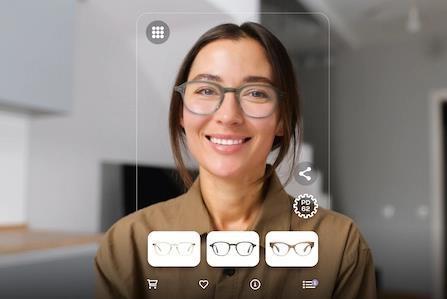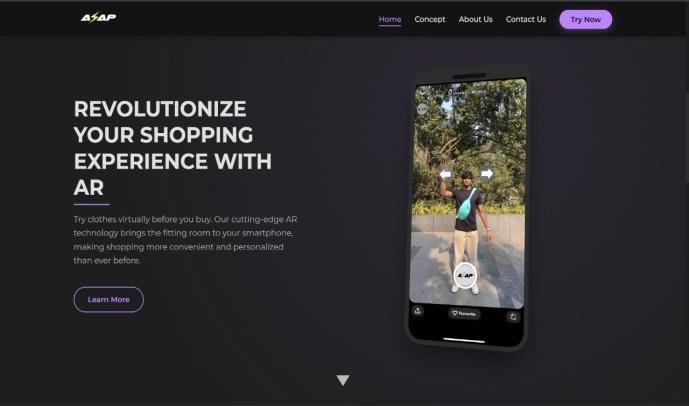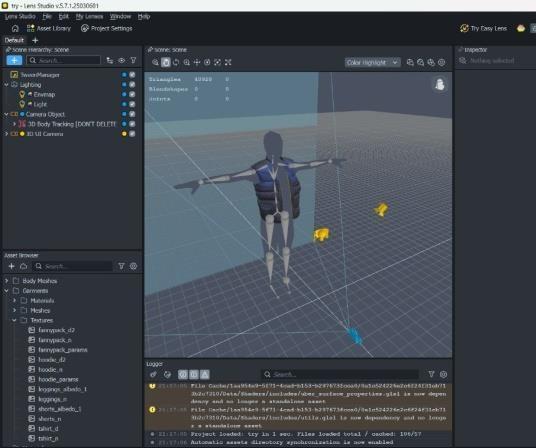
International Research Journal of Engineering and Technology (IRJET) e-ISSN:2395-0056


Volume:12Issue:05|May2025 www.irjet.net p-ISSN:2395-0072


International Research Journal of Engineering and Technology (IRJET) e-ISSN:2395-0056


Volume:12Issue:05|May2025 www.irjet.net p-ISSN:2395-0072
Aariya Vora1 , Swaraj Markad2 , Aditya Japtap3 , Prajakta Jadhav4 , Mrs. Sheetal Sapate
1Student, Dept. of Computer Technology, Bharati Vidyapeeth’s Jawaharlal Nehru Institute of Technology(poly.), Pune, India
2Student, Dept. of Computer Technology, Bharati Vidyapeeth’s Jawaharlal Nehru Institute of Technology(poly.), Pune, India
3Student, Dept. of Computer Technology, Bharati Vidyapeeth’s Jawaharlal Nehru Institute of Technology(poly.), Pune, India
4Student, Dept. of Computer Technology, Bharati Vidyapeeth’s Jawaharlal Nehru Institute of Technology(poly.), Pune, India
5Lecturer, Dept. of Computer Technology, Bharati Vidyapeeth’s Jawaharlal Nehru Institute of Technology(poly.), Pune, India
Abstract - The objective of this project is to develop an “AR Virtual Try on” for online or in store fashion environments, allowing users to wear virtual clothes in real time. By using AR Foundation with Snap AR, the system tracks the user's body and overlays 3D clothing models and gives a realistic try-on experience. Users can select clothes from a given set and use the AR interface to see what the outfit looks like without actually having to wear the outfits/accessories. This virtual mirror enhances customer experience, reduces dependence on fitting rooms, and introduces a new, modern efficient store shopping experience for retailers of fashion through integrating technology, convenience, and innovation for fashion merchants.
Key Words: Augmented reality (AR), Integrating Technology,Convenience,Innovation
AR (Augmented reality) is changing the way customers interactwithaproduct,especiallywithintheboundaries of the fashion and retail industry. This project focuses on the design and development of an AR-based virtual mirror that allows users to wear virtual clothing immediatelyontheirmobilephones.
Utilizing the robust AR toolset “Snap AR”, this project is lookingatthecreationofaseamlessandrealisticvirtual try-on experience, making the product accessible yet scalabletoanyfashionretailerandconsumer.
From 3D clothing models, body tracking, and interaction features, users can directly “see” how clothesfitandlook,withoutphysicalinteraction.


Snap AR delivers readily available AR capabilities, through which interesting, immersive experiences can bebuiltwithminimumdevelopment.Theprojectusesthe capabilityofalensforaninteractivevirtual mirror that shows fun engagement with users, enhanced customer satisfaction, and a quick approach of shopping experiencefortryingfashion.
“Shoppers face uncertainty when buying clothes online due to the inability to try them on, leading to wrong size selection and high return rates. In stores, trial rooms are inconvenient and timeconsuming, creating a need for a faster, interactive, andhassle-free solution.”
In online shopping, customers often struggle with uncertainty as they cannot physically try on outfits beforepurchasing.Thisleadstoincorrectsizeselection, and increased return rates (30-40%), negatively impacting both consumers and retailers. Similarly, in physical stores, traditional trial rooms pose challenges such as long wait times, hygiene concerns, and inconvenience, making the shopping experience less efficient.



As a result, a growing need for a new, engaging, and interactive waytotryonclothes/accessories onethat blends technology with fashion to create a fun, immersiveshoppingexperience.
We propose a Virtual Trial Room using Augmented Reality (AR). This system allows customers to digitally try on clothes in real time, and complementing physical trialroomstoenhancebothin-storeandonlineshopping experiences.
UsingSnapAR,thesolutionoverlaysdigitalclothingonto a user’s body through a camera, providing an accurate preview of how an outfit would look. This interactive and engaging approach not only makes shopping faster but also adds a fun and immersive element to fashion exploration.
Additionally, we integrate a Chatbot assistant. This AIpowered chatbot can recommend outfits based on user preferences, and provide style suggestions, making shoppingevenmorepersonalizedandefficient.
This technology has the potential for seamless ecommerce integration, enabling online shoppers to make confident purchase decisions while reducing return rates and improving overall customer satisfaction.
Online Shopping Improvement – Minimize uncertainty while buying clothes online by allowingcustomerstovirtually“tryon”clothes, boostingtheconfidenceinbuyingandlowering returns.
Simplifying In-Store Trial Rooms – Adding to existing fitting rooms an AR- based option, reducing dependency on in- store trials while retaining their availability for customers who demandthem.
PersonalizedFashion Support – Incorporatean AI-driven chatbot to offer immediate styling tips, size recommendations, and customer assistance, enhancing the shopping experience andease.
Technology Innovation – Utilizing Snap AR's advanced body tracking and 3D clothing overlays to deliver an engaging and highaccuracyvirtualtry-onexperience.


Volume:12Issue:05|May2025 www.irjet.net p-ISSN:2395-0072

Technology: LensStudio
Fig.2BodytrackingofferedbySnapAR
Future E-Commerce Integration – Establish a foundation for integrating this technology into online retail platforms, allowing users to experience virtual try- ons before making digitalpurchases.
5. LITERATURE SURVEY
There were manystudiesthatprovidedvery important insightsintovirtualtry-onsystems,poweredbyARand computer vision technologies, that happen to be the baseofourproject.
Thus, the paper "Virtual Mirror: A Hassle-Free Approach to Trial On Using Deep Learning" discuss virtual try-on clothing through deep learning in identifyingpostureconfigurationofthehumanbodyand overlayingvirtualgarments.
The study introduces a hybrid approach of 2D image processingand3Ddepthestimationthatmayleadtothe generationofrealisticvirtualtry-onmodels.
This is the conceptual base of our project-it helps in simulating the idea of how users can imagine putting garments on their bodies with the help of augmented reality.
The second paper is "Fashion Accessories Using Virtual Mirror,"whichfurtherdevelopsthisaspectand details how AR and webcams can be used to produce real-time tracking. It delves into the virtual try-on applicationinreal-time,wherebyusersinteractwiththe system to get immediate visualization of fashion accessoriesinmotion.
The study introduces a hybrid approach of 2D image processing and 3D depth estimation that may lead to thegenerationofrealisticvirtualtry-onmodels.Thisis theconceptualbaseofourproject-ithelpsinsimulating theidea of how users can imagine puttinggarments on theirbodieswiththehelpofaugmentedreality.


International Research Journal of Engineering and Technology (IRJET) e-ISSN:2395-0056

The second paper is "Fashion Accessories Using Virtual Mirror," which further develops this aspect and details how AR and webcams can be used to produce real- time tracking.
It delves into the virtual try-on application in real- time, wherebyusersinteractwiththesystemtogetimmediate visualizationoffashionaccessoriesinmotion.

Fig.3representsidea ofa3Dtryonversion.
This is the approach on which we rely to include realtime virtual clothing try-ons in our project, and its concentration remains on the real-time overlaying of virtualgarmentsfrombodytracking.
These papers together provide for a conceptual and practical framework for building a real-time, AR- based virtual mirror for fashion stores infused with deep learning forgarment fitting andreal-timeAR to enhance userinteractivity.
6. METHODOLOGY
1. SnapAR(LensStudio) forARDevelopment -
TheARtry-onfeatureisdevelopedusing Snap AR (Lens Studio), which utilizes real-time body tracking to accurately map 3D clothing onto the user’s body. The system detects posture,movements, and body dimensions, ensuring that virtual garments fit naturally and adjust dynamicallyastheusermoves.
For 3D model integration, clothing items are designed in Blender or Maya, where textures, rigging, and animations are fine-tuned for realism. These models are exported in FBX or OBJ formats, optimized for performance in Lens Studio, ensuring smooth rendering onmobiledevices&web.
2. WebPlatform(HTML,CSS,JavaScript)-
The web platform is developed using vanilla HTML, CSS, and JavaScript, ensuring lightweight performance andbroadcompatibility.Itservesasademoforbrands


Volume:12Issue:05|May2025 www.irjet.net p-ISSN:2395-0072
to integrate AR try-on and AI styling into their ecommercesites.Keyfeaturesinclude:
• Product Catalog: Displays clothing items with images, descriptions, in a clean, user- friendly layout.
• AR Try-On Button: Triggers the Snap AR experience, allowing users to virtually try on clothes directly in their browser.
• AI Chatbot Interface: A pop-up or embedded chatwindowwhereusersinteractwiththe Deep Seek+Llama3 modelforstylingadvice.
The platform is static (no backend server), making it easy to deploy and integrate with existing websites while maintaining fast load timesandsmoothfunctionality.
3. AIStylingChatbot(DeepSeek+Llama3)
The AI styling assistant ispoweredby Deep Seek with the Llama 3 model, providing intelligent, conversationalfashionrecommendations Unlikerulebased systems, this AI understands natural language queries, allowing users to ask for styling advice, outfit pairings,andtrend-basedsuggestionsinafluid,humanlikeconversation.
The chatbot UI is built with HTML, CSS, and JavaScript, offering seamless and interactive user experience. Users can type or speak their requests, and the AI responds with personalized recommendations, makingtheshoppingexperiencemoreengaging.
1. UserInteractionLayer:
Users interact with AR outfits via Snap AR interface.
AI Assistant provides real-time styling recommendations (optional, based on user preference).



International Research Journal of Engineering and Technology (IRJET)


2. ARProcessingLayer:
Uses Camera Kit SDK to access clothing modelsfromtheweb.
Real-time body tracking aligns outfits accuratelyontheuser.
Rendering Engine ensures fabric physics, lighting,andrealism.

3. AIStylingEngine(Optional):
Analyzestheuser’soutfitselection.
Suggests color combinations, accessories, and trendy fits
Future scope: Machine learning for personalizedrecommendations.
4. Cloud-BasedClothing&Rendering:
Clothing assets are fetched dynamically from theweb.
Cloud-based high-fidelity rendering for realistictextures.
Supports scalability and ensures
processing.


Volume:12Issue:05|May2025 www.irjet.net p-ISSN:2395-0072
5. Display&UserFeedbackLayer:
ThefinalARoutfitisrenderedon-screen.
Users can interact, change outfits, and receiveAIsuggestions.
Future scope: Social sharing & feedback integration

Fig.7 showcasing ASAP system architecture
8. TOOLS
● Lens Studio (Snap AR): Core platform for
building the AR lens, managing body tracking, and 3D rendering.
● Body Tracking: In-built Snap AR body trackingforfittingclothestotheuser'sbody.

● 3D Modeling Tools: Tools like Blender or Maya for creating and exporting 3D clothing modelsinformatssuchasFBXfromCGtraders.
● Scripting in Lens Studio: For adding interactionsliketap-to-change.
● Chatbot Integration: Avirtualassistantwithin theARexperiencetoguideusersthroughoutfit selections, provide styling tips, and enable voice/tapcommandsfortryingonclothes.


International Research Journal of Engineering and Technology (IRJET) e-ISSN:2395-0056

E-commerce Integration: E-commerce platforms can integrate virtual try-on technology to let customers visualize clothing before buying. This reduces return rates and improves customer confidence, making online shopping more effective.
Offline Fashion Stores: Virtual mirrors in physical stores allow customers to try on clothes without needing fitting rooms, enhancing convenience and reducing wait times during busy periods. This also helps stores optimize floor inventory and boost customerengagement.
New Season Sales: Virtual mirrors can showcase new season collections, letting customers instantly try on the latest trends, driving sales and offering personalized recommendations for seasonal promotions. SimilarExample-NIKE.

AR Redirect to Website: After virtually trying on clothes, customers can be redirected to the product's page online for easy purchasing. This is ideal for hybridretailmodels,where in-storeorpop-upexperiencesdriveonlinesales throughARinteractions.
10. LIMITATIONS AND CHALLENGES:
A) Limitations:
No Unity/Unreal Engine Integration: Due to limited expertise in high-end AR tools, we optedforamoreaccessibleapproach.


Volume:12Issue:05|May2025 www.irjet.net p-ISSN:2395-0072
Hardware Constraints: Advanced tools require powerful hardware, making it impractical for allusers.
Prototype Stage: The system is a working prototype using Snap AR, limiting advanced customization.
Rendering Realism: While functional, the current rendering approach lacks ultrarealisticfabricphysicsanddynamiclighting.
Addressing these through better physics engines and adaptive lighting algorithms could enhance AR realism andreliability.
B) Why?SnapARchallenges:
1.CostFactorsofWebAR-
Platforms like 8th Wall provide multiple advanced features but are costly, therefore not usable for low-budget projects. Alternative is free options, but they lack some of the functionalities and do not include real-time body tracking or realistic cloth simulations, so wehavetolookatalternatives.
2. Unity’s High Processing RequirementsWhile Unity providesrobustAR tools,itshighendprocessingdemandsmakeitunsuitablefor mobile devices with lower specifications. This limitsitsaccessibilityandconsistentperformance acrossdifferentuserdevices.
3. Snap AR's Cross-Platform Compatibility is Limited-
Most AR platforms are either feature-poor or requireintenseinvestment.Itisraretostumble on platforms that offer affordability coupled withadvancedARcapabilities.
Therefore,SnapARisabalancedchoiceasitoffersa user-friendly interface along with sufficient functionality.
E-Commerce & Social Shopping - AR try- ons will boost live shopping. AI stylists will host virtual consultations. 3D printing will enable instant customization.
Advanced AI Stylist-GPT-4 will suggest outfits based on preferences. Mood-sensing AI will design clothes matching emotions. Custom AI-generated styles will trend.


International Research Journal of Engineering and Technology (IRJET) e-ISSN:2395-0056

Blockchain for Digital Fashion - NFT- linked outfits ensure exclusivity and resale value. Smart contracts will automate designer royalties. Crossplatform wearables will dominate metaverse fashion.
Hyper-Realistic Digital Clothing -Physicsengines will mimic fabric movement accurately. Photorealistic textures will enhance virtual garments.AIwillperfectdigitalfit redictions.
Metaverse Integration-Avatars will try outfits in VR stores, enabling immersive shopping. Virtual fashionshowswillletusersbuy looks instantly.
Sustainability & Ethical Fashion - Digital collectionswillreducetextilewaste.Blockchainwill track eco-friendly sourcing. AI will optimize sustainablematerialusage.
Biometric & Adaptive Fashion -Smartfabricswill monitor health metrics. Climate- responsive wearables will adjust automatically. Gesturecontrolledoutfitswillpersonalizestyledynamically.
Thisprojectmergesonlineandofflineshoppingthrough an AR Virtual Try-On + AI Styling Assistant, enhancing engagementandreducingreturns.
Customers can try clothes digitally in real-time, complementing physical fitting rooms and boosting ecommerceconfidence.
Future upgrades like cross-platform AR and fabric simulation will deepen realism. By blending innovation with convenience, this solution transforms retail driving sales, cutting waste, and delivering a seamless, futuristicexperience.
Thefutureoffashionishere:smarter,more immersive, andcustomer-centric.
We would like to extend our sincere gratitude to all those who contributed to the completion of this paper on ASAP – AR based virtual try-on with AI styling Assistance. Special thanks to our mentors and advisors fortheirguidanceandsupportthroughouttheresearch process.
Additionally, we appreciate the assistance of our colleagues and peers who offered their feedback and suggestions.


Volume:12Issue:05|May2025 www.irjet.net p-ISSN:2395-0072
[1] Virtual Mirror: A Hassle-Free Approach to Trial On Using Deep Learning: https://www.researchgate.net/publication/36 2539676_Virtual_Mirror_A_Hassle_Free_Appro ach_To_Trial_On_Using_Deep_Learning
[2]Fashion Accessories Using Virtual Mirror:https://www.ijsce.org/wpcontent/uploads/papers/v5i2/B2578055215.pdf
[3]Virtual Mirror Complete Guide: https://www.banuba.com/blog/virtual- mirrorcomplete-guide
[4]https://www.tbsnews.net/tech/snap- offering-arshopping-experience-605254





AariyaVora DiplomainComputerTechnology
SwarajMarkad DiplomainComputerTechnology
AdityaJaptap
DiplomainComputerTechnology
PrajaktaJadhav DiplomainComputerTechnology
LecturerMrs SheetalSapate MTechinInformationTechnology
